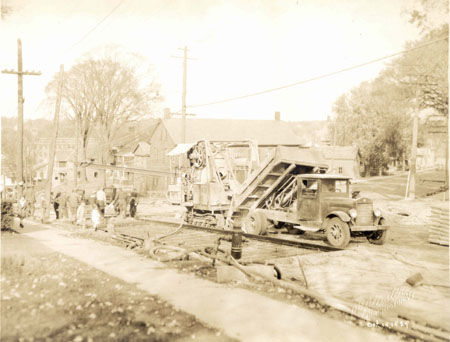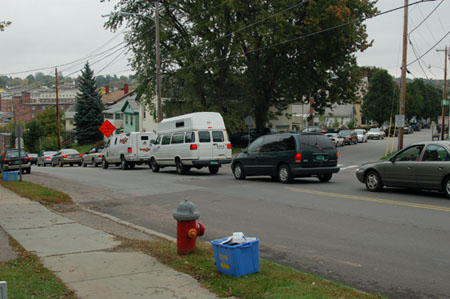

 |
 |
7., 8., & 9. COLCHESTER AVENUE AT CHASE STREET WITH ROAD CONSTRUCTION EQUIPMENT October 19, 1929 A series of three images show the progress of the roadwork along Colchester Avenue during the fall of 1929. Because of the steep grade of the hill in this area, the Burlington Street Department made the decision to pave the roadway with concrete. The three photographs illustrate the process of pouring one of the three concrete slabs. After the street grade was lowered and leveled, steel rod reinforcing mats were rolled atop it and secured with iron rails. Joints were placed at intervals of forty-four feet, which was the length of the slabs.[1] Finally, concrete was poured into the forms.
In his memoir Salute to Burlington, Robert A. Michaud recalls observing the road crew at work along Winooski Avenue in 1929 when he was a boy: "My comrades and I enjoyed watching this labor intensive project… The men shoveled sand and bagged cement into a hopper that was hoisted into the jaws of the mixer compartment of a large machine. The mixing cylinder rotated noisily until the concrete was ready to pour. The contents were emptied into a gondola that carried the concrete along a long suspended rail to the desired drop area in the form to be filled. The poured concrete was then leveled by brawny, barebacked laborers by hand shovel. Prior to the concrete ‘setting up,’ the wet concrete was finish-troweled within the frame to get the correct slope. After this operation, the concrete was covered with a large canvas tarpaulin, and for several days water was applied to aid in the curing process."[2]
In this case a dump truck, rather than the men, empties sand into a funnel connected to a motor-driven cement mixer. Bags of cement mix are visible in the right corner of the first image, and a fire hose connected to a hydrant supplies the water. The second image shows the concrete being poured from the gondola into the form, while the work crew begins to level the poured concrete in the third photograph. A ditch excavated for the new gutters and curbs is visible on the left in all of these images. It appears to be quite deep, as a boy or a young laborer can be seen sitting at the edge of the ditch with his legs dangling into it. What appears to be a tarpaulin like the one mentioned by Michaud covers part of the road in the foreground. According to George Stanley, the street construction project was executed according to specifications by the Vermont State Highway Department.[3] The materials, technology and machinery illustrated in this series of photographs are impressive. [1] Annual Report of the City of Burlington (1929), 238. [2] Robert B. Michaud, Salute to Burlington: An Informal History of Burlington, Vermont (Lyndonville: Lyndon State College, 1991), 134. [3] Annual Report (1929), 237.
|
7. & 8. COLCHESTER AVENUE AT CHASE STREET (18T 0644154 UTM 4927481) and 9. CEMENT MIXER ON COLCHESTER AVENUE October 11, 2005 Note the water hydrant in the same position as in the 1929 photographs. The sidewalk and curb appear to be the same as in the older images as well. The concrete surface laid down in 1929 has been covered by several layers of asphalt paving, for the level of the road is now nearly flush with the top of the curb.
(18T 0644156 UTM 4927489)
The third image shows a modern cement mixer on Colchester Avenue next to the Green Mountain Cemetery, included here as a comparison with the cement mixer in the 1929 documentation.
(18T 0644166 UTM 4927510) |
Colchester Avenue east of East Avenue, Barrett and Mill Streets
Historic Burlington Project Burlington 1890 | Burlington 1877 | Burlington 1869 | Burlington 1853 | Burlington 1830 Produced by University of Vermont Historic Preservation Program graduate students in HP 206 Researching Historic Structures and Sites - Prof. Thomas Visser in collaboration with UVM Landscape Change Program Historic images courtesy of Louis L. McAllister Photograph Collection University of Vermont Library Special Collections |